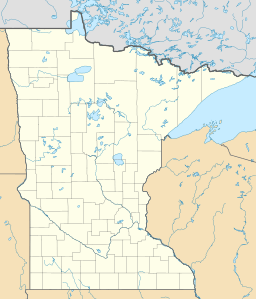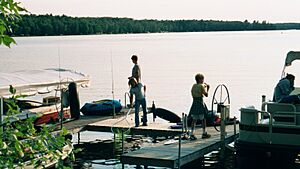Bay Lake (Minnesota) facts for kids
Quick facts for kids Bay Lake |
|
|---|---|

Typical scene
|
|
| Location | Crow Wing County, Minnesota |
| Coordinates | 46°23′08″N 93°51′24″W / 46.385425°N 93.856544°W |
| Catchment area | 23 sq mi (60 km2) |
| Basin countries | United States |
| Surface area | 2,393 acres (9.68 km2) |
| Max. depth | 74 ft (23 m) |
| Residence time | 4-7 years |
| Islands | Malkerson Island Church Island |
| Settlements | Bay Lake |
Bay Lake is a beautiful body of water in the Brainerd Lakes region of Minnesota. It's quite large, covering about 2,319.84 acres (9 km2) and having nearly 19 miles (31 km) of shoreline. The deepest part of the lake is 74 feet (23 m). Its water is very clear, so you can see about 24 feet (7 m) down! The Ojibway people, who lived here long ago, called the lake Ses-sa-beg-a-mah. This name means "lake of many bays" or "lake of many arms."
Contents
Where is Bay Lake?
Bay Lake is located in Bay Lake Township. It's about 15 miles (24 km) east of Brainerd, Minnesota. It's also five miles (8 km) northwest of Garrison, Minnesota. You can reach the lake by driving on Minnesota State Highway 6 or Crow Wing County Highway 10.
Fun Things to Do at Bay Lake
Many people love to visit Bay Lake. It's a popular spot for outdoor activities.
- Fishing: The lake is a great place to catch fish.
- Boating: You can enjoy boat rides on the clear water.
- Water Skiing: Many visitors love to water ski here.
Like other lakes in the area, Bay Lake has many resorts and private cabins. These places offer fun stays for families and friends.
Islands of Bay Lake
Bay Lake has three islands. The biggest one is called Church Island. It's about 72-acre (290,000 m2) in size. Church Island is used as a Lutheran church camp. During the summer, outdoor church services are held on the island every Sunday. Everyone is welcome to attend these services.
The Ripple River Connection
Bay Lake is important for the Ripple River. It's one of the starting points, or "headwaters," for this river. The Ripple River is also a common place where fish go to lay their eggs. This helps new fish grow and keeps the lake's ecosystem healthy.



